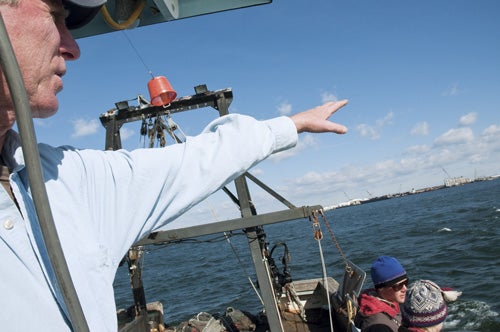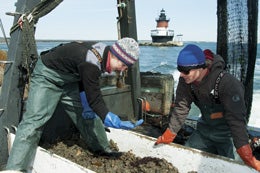Trawling for Deeper Understanding

Climbing aboard the research boat Cap’n Bert in April to trawl for fish in Narragansett Bay, the weather looked somewhat ominous, with gusty winds and threatening skies. But like iconic postal workers, the weather never stops Captain Tom Puckett and oceanography graduate student Anna Malek from their appointed rounds. In fact, every single week since 1959, a student from the Graduate School of Oceanography has trawled for marine life in the exact same two places the Cap’n Bert was headed, producing a data set that is virtually incomparable anywhere on Earth.

“It’s one of the longest continuous studies of marine ecosystems anywhere,” said Professor Collie.”
Not far from Fox Island, a few miles north of the Jamestown-Verrazzano Bridge, Malek dropped a device into the water to measure the temperature, salinity, and dissolved oxygen at several depths, then released an otter trawl behind the boat to drag the seafloor. Thirty minutes later, the net was hauled in and a lobster pot-sized mass of marine life was dumped on the deck.
Most of the catch was tunicates, sac-like invertebrates that live on the bottom and which Malek described as looking like “muddy ice cubes.” But mixed in among the tunicates were dozens of spider crabs, several prehistoric-looking mantis shrimp, three varieties of flounder, a lobster, and a few other odds and ends. As Malek and undergraduate Sam Collie sorted, counted, and weighed the catch, Puckett steered the boat toward the rough seas at the mouth of the Bay to do it all over again.
The weekly fish trawl is managed by Professor Jeremy Collie, Sam’s father, who assumed responsibility for it in 1998 from Professor Emeritus Perry Jeffries, caretaker of the project for the previous 30-plus years. But it was Charles Fish, co-founder of the Graduate School of Oceanography, who launched the project to learn about the seasonal occurrences of fish in Narragansett Bay. He had no intention of making it a long-term project, and he certainly never envisioned that it would continue for more than half a century.

As the GSO celebrates its own half-century mark this year, the ongoing fish trawl research is considered by many to be one of its crowning achievements.
“It’s one of the longest continuous studies of marine ecosystems anywhere,” said Professor Collie. “The data are used in high-profile studies of the global syntheses of long-term trends in fish abundance. And they have regional significance, too, as a measure of the pulse of Narragansett Bay.”
Over the years, more than 2 million individuals of 130 species have been captured, recorded, and returned to the sea, providing valuable insight into the evolving composition of marine life as environmental conditions change. While the total abundance of fish and other creatures peaked in the 1990s, Collie said that the number of individuals and the variety of species has experienced significant shifts.
The community of marine life in the bay shifted from predominantly fish to predominantly invertebrates (lobsters, crabs, and squid) and from those that live on or near the bottom to those that feed higher in the water column, he said. In addition, smaller, warm-water species have increased while larger, cool-water species have declined.
“Few species have stayed the same over the life of the project,” Collie said. “They either increased or decreased a lot.”
The big losers in this process have been tautog, sculpin, hake, and cunner, while the winners have been lobsters, crabs, butterfish, and bluefish. The one wildcard has been winter flounder, what Collie calls “the poster fish for Narragansett Bay,” which fluctuated wildly in abundance before decreasing in recent years.
The culprit in many of these shifts is climate change. The average temperature in the Bay has increased by 2 degrees Celsius since the start of the trawl survey, which helps to explain why species preferring cool temperatures have declined while those preferring warm waters have increased.
“Some species are better than others at shifting their ranges,” Collie said. “Those that spawn offshore, like butterfish, aren’t as tied to a particular location, whereas winter flounder, which spawn in the bay, can’t easily move north and instead just disappear.”
The warming water has also resulted in a reduction of phytoplankton, the microscopic plants that form the basis of the marine food web. Now that it is warm enough for the tiny marine creatures called zooplankton to remain in the Bay during the winter, they are ready to feed on the phytoplankton as soon as it blooms. Collie said that may be the reason why bottom feeding fish have declined in favor of those that live higher in the water.
“As soon as the phytoplankton blooms, the zooplankton eat it, leaving nothing to rain down to feed the fish at the bottom,” he said.
Asked what the next species shift is likely to be in Narragansett Bay, Collie said that the fish community in the Bay will begin to more closely resemble estuaries to the south, like Delaware Bay and Chesapeake Bay. In particular, he expects an increase in the population of blue crabs.
“Instead of eating lobster rolls around here, we’re going to be eating crab cakes,” he said.
As important as the weekly fish trawl is to the global community of fisheries researchers and to state officials who seek to manage the Bay ecosystem, the project also has a very human side that represents the community of oceanographers at URI.
“As we reflect back on the 50 year history of GSO, it’s worthwhile noting that the trawl has involved three different faculty members, along with generations of graduate students providing valuable contributions. We have a lot of human capital invested in this project, and it’s something that we all can be proud of.”
At Whale Rock, where the turbulent waters of Rhode Island Sound merge with the calmer Bay waters, Anna Malek followed the same procedures as before, taking measurements of the marine conditions and then dropping the net overboard. The weather had worsened, but the students seemed to hardly notice.
Malek said she enjoys following the tradition of the many GSO students before her, going out on the water on a weekly basis and observing how the community of marine life changes from season to season and year to year. She has come to expect the unexpected, including the various tropical fish species that arrive in the Gulf Stream every year and the giant torpedo rays that can jolt you with an electric shock if touched.
But today’s second trawl wasn’t nearly that exciting. It did, however, contain a great deal more than the first trawl of the day: dozens of skates, each looking like a giant square dinner plate with a tail, hundreds of rock and Jonah crabs, more lobsters and flounder, and the first Atlantic cod of the year, which brought a big smile to the crew, since they typically only catch one a year.
“It was a much larger haul than last week,” Malek said. “It’s a good sign. The seasonal movement of fish into the bay is finally beginning.”
Added Collie, “Every time we go out there, we’re collecting another little piece of the puzzle. It all adds up over time.”
By ToddMcLeish
 Home
Home Browse
Browse Close
Close Events
Events Maps
Maps Email
Email Brightspace
Brightspace eCampus
eCampus


